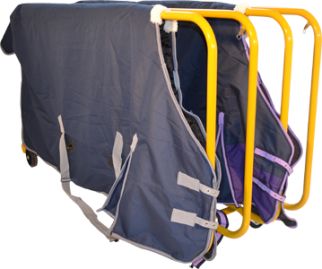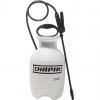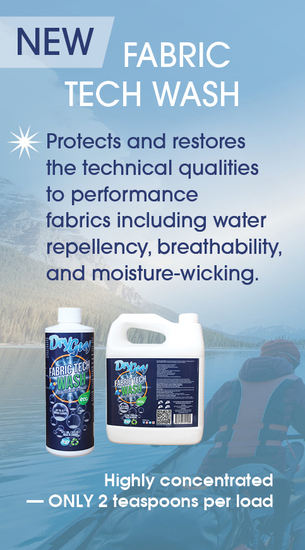Daily Wear and Tear
Horses are tough on blankets – it’s a fact of life. They roll in them, get them covered in mud, manure and urine, and use them to play tug-of-war. There are, however, a number of steps to take to ensure your blankets live a long and useful life.
To begin with, make sure the blankets you buy are the best you can afford, the correct size and properly fitted for your horse. Dangling straps can easily be snagged and broken; a rug that’s too snug will wear quickly on the pressure points such as shoulders and withers (and chafe your horse); a loose-fitting blanket will shift and can even become dangerous if the horse gets entangled in it.
Inspect your horse blankets for damage on a daily basis; loose or frayed straps or damaged hardware should be repaired immediately. Even a relatively small hole or tear will render the weatherproofing ineffective and let moisture in, which can cause discomfort or skin irritation for the horse. Blankets should be hung to dry – unfolded – on a rack or the fence if they get wet, then brush the mud and hair off before using again. For this reason, it is advisable to have an inexpensive back-up blanket to use while one is drying or out being washed or repaired. Always hang blankets unfolded on a rack between uses, even if they are dry, rather than slinging them into a corner of the tack room.
Lori Hirst, owner of Sho-Clean Horse Blanket Specialists in Newmarket, ON, for 16 years, was “born into the laundry and dry cleaning business,” thanks to her parents. Her lifelong experience with horses leads her to believe that while the obvious solution to keeping blankets safe from tearing teeth is turning horses out separately, this is often neither practical nor fair. “They’re herd animals. You’re better off to pick the right horses to be turned out together,” she insists.
Carrie Mathers, owner of Hoof Hearted Horse Laundry Services in Chilliwack, BC, disagrees. “If you want blankets to last you have to keep horses separate. My horses are in separate paddocks and never have a blanket tear unless they catch it on the fence.” She also suggests finding a blanket with the least amount of seams. “The more seams, the more places to rip.”
To discourage pasturemates from playing Eat-The-Blanket, try bitter spray-on products made especially for this purpose, or provide pasture toys such as play balls or even hang up old jeans with the buttons removed to satisfy the bored horse who like to chew.
Cleaning
Do-It-Yourself: Most often, a simple spot-cleaning is sufficient for mid-season blanket touch-ups. This can be done via a vigorous brushing with a stiff brush to remove dirt and debris. If you need to wash your blankets, use a large front-loading washer (never a top load, as the blanket will tangle on the spindle and can damage the machine). At this juncture I will suggest you do not subject the washing machines at the local laundromat to this sort of abuse, even though most of us have at some point; the owners will be very annoyed, as will the person who uses the machine next to wash their dainties! A few laundromats are horse blanket friendly, but be sure to get the owner’s permission first, and abide by their rules, which will likely mean that you run an empty wash cycle after you’re done.
Before washing, brush off as much hair and mud as possible, and shake out thoroughly. Use a lint roller to remove any remaining hair, or if it is really hairy, turn the blanket inside out and spray thoroughly with a high-pressure hose, after which you may be able to use a stiff curry or shedding blade to remove additional hair. Spray soiled spots with colour-safe stain remover, testing first on a non-conspicuous area. Tighten all the straps in as far as they will go.
Use a mild laundry detergent and put the blanket through both the wash and rinse cycles at least twice, using cold or warm (not hot) water, and never use bleach. Says Hirst of her company’s cleaning method, “We do two pre-washes, two washes, and five rinse cycles. Don’t overstuff the washer, or nothing will get clean, and never throw blankets in the dryer. It compresses the loft, and the thread and polypropylene lining shrinks.” The preferred drying method is to hang them in a well-ventilated area on a rack or over a rail.
Do-it-yourselfers can refresh their blanket’s waterproof capabilities either by adding waterproofing with the wash, or by applying a spray-on product such as Horse Blankets & Pet Apparel Spray. Other weatherproofing formulas such as Scotchguard or other commercial silicone sprays can be used, but check the label and do some research to make sure there are no ingredients which may be harmful to your horse.
Using The Pros: It is advisable to have your blankets professionally cleaned, waterproofed and repaired once a year, especially at the end of the season before they are stored. At Hoof Hearted, a blanket will be cleaned, dried, properly folded and bagged – a small price when you consider your initial investment. Sho-Clean provides winter blanket cleaning and inspection, and weatherproofing, which also inhibits the growth of mildew. Some blanket repair shops offer farm pickup and delivery, 24-hour turnaround, and even summer storage if you’re short of space.
Hirst offers this wisdom: “Don’t buy cheap blankets. I’ve seen old Rambo and Bucas come into the shop that are nearly 20 years old. It’s better to pay $300-plus for a good blanket and bring it in once a year to be washed and waterproofed.”
Repairs
Both Mathews and Hirst agree that the most common blanket repairs they see are tears, followed closely by gussets at the shoulders coming apart, missing surcingles, leg straps, and buckles.
Says Hirst, “Small repairs can be done by the owner with an awl or even duct tape, but when it comes to buckles, you should get them fixed by a pro. This is another instance when you should have a cheaper spare blanket on hand.”
If you are handy, you can attempt simple repairs yourself. If the tear is small, seal it up by using an iron-on patch in a matching colour. Larger tears can be sewn with an awl or very large needle and sturdy nylon thread. Unless you have an industrial sewing machine you are best to hand-sew your repairs, working from the back side of the fabric to make it as invisible as possible. “Some of my clients use Shoo-Goo on the edge of tears, which seals and waterproofs,” says Mathews. Shoo-Goo, available at most sports apparel stores, is polyurethane-based adhesive intended for athletic footwear repairs which apparently has found new uses around the barn.
The obvious advantage to having the pros handle repairs is that they are fully stocked with quality fabrics, hardware and webbing and can match original colours as closely as possible.
Storage
“Never throw your dirty blankets into a room at the end of the season, or mold and mildew will eat the
fibre,” warns Hirst. Instead, it should be cleaned and properly dried – either pr
ofessionally or by the owner – folded and placed in a sealed bag or preferably a plastic storage container if mice are a problem in the barn. In a multi-horse stable, it is a good idea to identify the blankets with the horses’ or owner’s names. To keep them fresh-smelling while they sit over the summer, you can even add a fabric softener sheet to the bag or bin.



















Comments